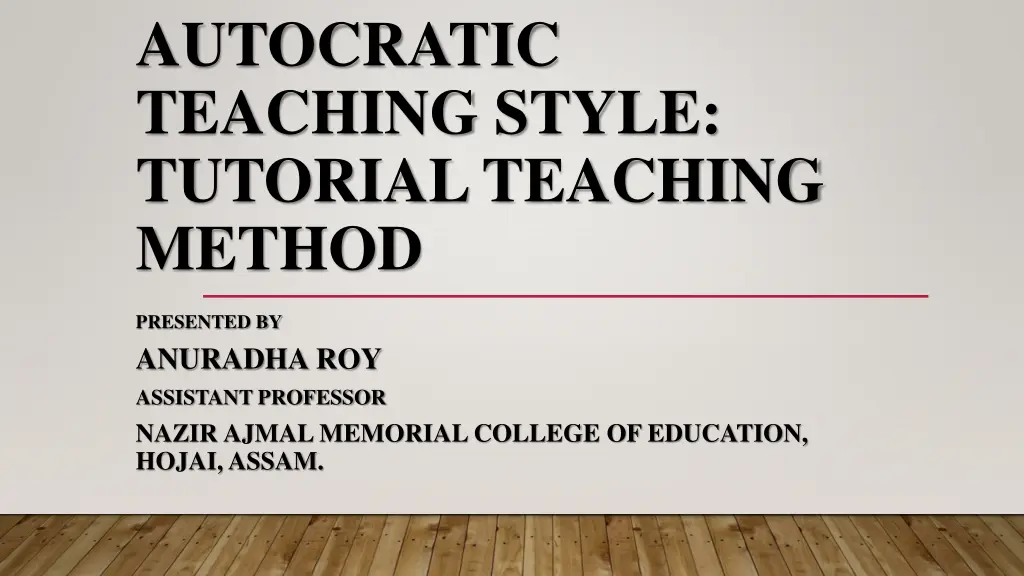
Tutorial Teaching Method Explained | Characteristics, Objectives, and Strategies
Explore the tutorial teaching method presented by Anuradha Roy. Discover its characteristics, objectives, types, and strategies for effective tutorials. Learn how tutorial teaching enhances student learning and academic abilities.
Download Presentation

Please find below an Image/Link to download the presentation.
The content on the website is provided AS IS for your information and personal use only. It may not be sold, licensed, or shared on other websites without obtaining consent from the author. If you encounter any issues during the download, it is possible that the publisher has removed the file from their server.
You are allowed to download the files provided on this website for personal or commercial use, subject to the condition that they are used lawfully. All files are the property of their respective owners.
The content on the website is provided AS IS for your information and personal use only. It may not be sold, licensed, or shared on other websites without obtaining consent from the author.
E N D
Presentation Transcript
AUTOCRATIC TEACHING STYLE: TUTORIAL TEACHING METHOD PRESENTED BY ANURADHA ROY ASSISTANT PROFESSOR NAZIR AJMAL MEMORIAL COLLEGE OF EDUCATION, HOJAI, ASSAM.
Definition: Tutorial is a method of transferring knowledge and maybe used as a part of learning process. Under these method a class is divided into groups according to the capacities of the students should be covered and every child should get the chance to express himself or herself individually. Wikipedia defines a tutorial as a method of transferring knowledge and maybe used as a part of a learning process more interactive and specific then a book or lecture it tutorial seeks to teach by example and supply the information to complete a certain task.
Characteristics: 1. This method is a time of remedial teaching and can be suited in teaching natural science and mathematics subject. 2. Tutorial teaching is also called remedial teaching. 3. Tutorial teaching is a method which is delivered after lecture. 4. The aim of these method is to help the students to improve their cognitive and other academic abilities
Objectives: 1. Develop student's ability to think and act like a professional in their discipline. 2. Develop student's basic academic skills, like effecting communication both oral and writing, effective time management, critical self assessment. 3. Enable students to learn how to think for instance to synthesize disparate sources, to formulates and justify it. 4. To anticipate criticism of their arguments and to respond to questions and challenges-- thinking on one's feet in the tutorial setting.
Continue 5. Enable students to pursue their individual academic interest within the context of their subject. 6. Help students to gain a deep understanding of the subject matter in their discipline. 7. Help students to see the significance and implications of their knowledge so they can apply their learned contents.
Types of Tutorial: Group Tutorial Types Supervised Tutorial Practical Tutorial
Strategies for effective tutorials: Planning Questions Communication Activities Delivery Motivation
Advantages: 1. Enables users to learn on demand and when they are motivated. 2. Tutorial can be done independent of time. 3. User is able to stop for breaks and to repeat sections as needed. 4. Easier to briefly review or skip sessions if not a beginner. 5. Learning through written communication may be easier than, learning through oral communication. 6. Less ongoing staff time is needed for instruction.
Continue 7. Experts can devise a tutorial, even though they are located at a different institutions. 8. It enables them to develop fundamental skills of listening, presenting ideas and persuading others. 9. Teaching learning in tutorial classes allows students and opportunity to negotiate meaning, express themselves in the language of the subject.
Disadvantages: 1. Individually, motivation is not possible sometimes. 2. Density of presentation is sometimes high because of content that creates a monotonous environment. 3. Sometimes it is not possible to ask questions to each participant or solve each participant's difficulties. 4. Frequently novices longer to learn via tutorial than via classroom setting.
